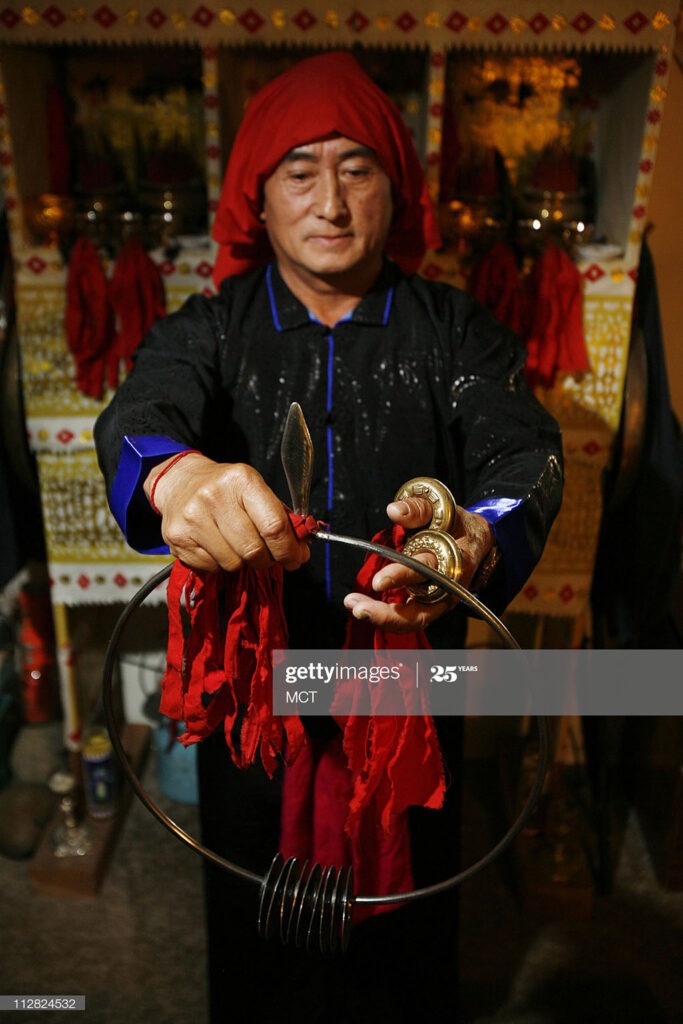
Hmong Traditions – Rituals & Ceremonies: Soul Calling
Soul-Calling:

One ritual and ceremony would be the “existence of souls” also known as “soul-calling”, is often performed when a person is sick. This is sometimes complemented by the use of herbal medicine and magic formulas or “khawv koob” to extract the bad spirit from the body of the sick person or to heal a broken limb. If a person is sick and the illness is determined to have been cause by the spirits a shaman will be consulted. The shaman would have to take a journey into the spirit world and must persuade the spirits to withdraw whatever curse they put on the person. Usually an apology is made and paper money is offered to compensate for the offense. When someone becomes ill, it is common for the family to conduct a soul calling (hu plig). Depending on the nature and severity of the illness, the family might turn to a Shaman for the cure, especially when it is suspected that the cause of the illness may be the result of a soul that has wandered afar or taken captive by a malevolent spirit.
Known as “soul loss (poob plig), these situations can sometimes be serious and require special measures to find and retrieve the soul. While many Hmong may perform soul callings, the Shaman is considered the expert in serious cases Because a lost soul may be asleep or held captive in the unseen world the Shaman must first use special divination horns known as kuam to uncover where the soul is located and how to recover it. Next, the Shaman enters a trance as he or she journeys into the spirit world to retrieve the soul. This journey commences by standing on a plank or bench in front of the alter, which represents mounting flying spirit horses. The shaman enters the spirit world through the Strings and Bamboo (xyoob thiab sob), which are hung up on the ceiling. Shamans use the strings as a bridge, which will lead them to their spiritual destination. Burning of paper moneyDuring the trance, the Shaman voices a special chant to entice the soul to return.
During this journey, the Shaman covers his or her face with a piece of fabric for concealment and protection from evil spirits which may impede the soul calling. To further entice the soul, the Shaman uses the soul of a sacrificed pig or cow to temporarily take the place of the lost soul. Special paper or “spirit money” is then burned, which rewards the soul of the animal for its sacrifice. The shaman orders the pig to sit in place of the soul as the Shaman guides the soul back to the body. It could take up to a year for the soul to return. When the soul has fully returned, the shaman must free the soul of the sacrificed animal. He does so by burning the jaw bone. See video of a Shaman chant during a soul calling. Shaman as he stands on the plank or bench. Because of the physical nature of the soul calling, helpers ensure that Shaman does not fall while performing the ceremony.
Helpers may also be responsible for burning the paper (spirit money) for the replacement soul and tasked with striking the gong (nruas neeb.) The purpose of the gong is to call the assisting spirit to help the shaman and to permit the shaman to enter a trance and then later exit from the trance. During the trance and spiritual journey, the shaman may encounter evil spirits and may even be forced to fight. At times, the battle can be so intense that the Shaman may fall to the floor make expressive noises. If the bad spirit is too powerful, the shaman will have to use the divination horns (kuam) to see if the spirit can be defeated. If the divination horns indicate no, the shaman will have to stop. After the shaman completes the journey, a table of food, is served by the family to relatives and friends, The Shaman is paid for his or her services and given some of offered some of the meat that was from the sacrificed pig or cow.
The shaman also takes home the jawbone of the pig, and burns it so that the sacrificed pigs can be reborn.





Responses